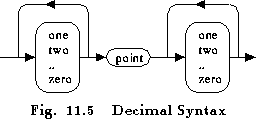
As mentioned in the introduction, the main function of HBUILD is allow a word-level network to be constructed from a main lattice and a set of sub-lattices . Any lattice can contain node definitions which refer to other lattices. This allows a word-level recognition network to be decomposed into a number of sub-networks which can be reused at different points in the network.
For example, suppose that decimal number input was required. A suitable network structure would be as shown in Fig. 11.5. However, to write this directly in an SLF file would require the digit loop to be written twice. This can be avoided by defining the digit loop as a sub-network and referencing it within the main decimal network as follows
# Digit network
SUBLAT=digits
N=14 L=21
# define digits
I=0 W=zero
I=1 W=one
I=2 W=two
...
I=9 W=nine
# enter/exit & loop-back null nodes
I=10 W=!NULL
I=11 W=!NULL
I=12 W=!NULL
I=13 W=!NULL
# null->null->digits
J=0 S=10 E=11
J=1 S=11 E=0
J=2 S=11 E=1
...
J=10 S=11 E=9
# digits->null->null
J=11 S=0 E=12
...
J=19 S=9 E=12
J=20 S=12 E=13
# finally add loop back
J=21 S=12 E=11
.
# Decimal netork
N=5 L=4
# digits -> point -> digits
I=0 W=start
I=1 L=digits
I=2 W=pause
I=3 L=digits
I=4 W=end
# digits -> point -> digits
J=0 S=0 E=1
J=1 S=1 E=2
J=2 S=2 E=3
J=3 S=3 E=4
The sub-network is identified by the field
SUBLAT in the header
and it is terminated by a single period on a line by itself. The
main body of the sub-network is written as normal.
Once defined, a sub-network can be substituted into a higher level
network using an L field in a node definition, as in nodes
1 and 3 of the decimal network above.
Of course, this process can be continued and a higher level network could reference the decimal network wherever it needed decimal number entry.
One of the commonest form of recognition network is the word-loop where all vocabulary items are placed in parallel with a loop-back to allow any word sequence to be recognised. This is the basic arrangement used in most dictation or transcription applications. HBUILD can build such a loop automatically from a list of words. It can also read in a bigram in either ARPA MIT-LL format or HTK matrix format and attach a bigram probability to each word transition. Note, however, that using a full bigram language model means that every distinct pair of words must have its own unique loop-back transition. This increases the size of the network considerably and slows down the recogniser. When a back-off bigram is used, however, backed-off transitions can share a common loop-back transition. Fig. 11.6 illustrates this. When backed-off bigrams are input via an ARPA MIT-LL format file, HBUILD will exploit this where possible.
Finally, HBUILD can automatically construct a word-pair grammar as used in the ARPA Naval Resource Management task.